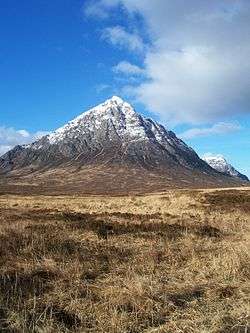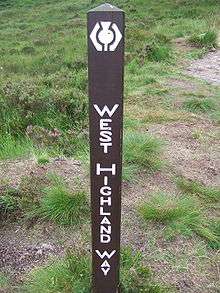West Highland Way
The West Highland Way (or W.H.W.) is a 95 mile (152 km) long-distance walk from Milngavie outside Glasgow, to Fort William in the Highlands of Scotland. It is one of four officially-recognised "Long-Distance Routes" in Scotland.
- This article is an itinerary.

Get in
Although it is of course possible to walk from Fort William to Milngavie, the general advice is to use the more gentle terrain in the south as a warm-up to the remote and dramatic mountain areas further north, plus you will have the sun behind you. Milngavie is best reached from Glasgow city centre. Regular bus and local train services depart throughout the day from Buchanan Street Bus Station and Queen Street Railway Station respectively. The Kelvin Walkway is the best route if you wish to cycle or walk from the city.
Fort William has a three times daily train service and three times daily bus service both to Glasgow. Prices are around £15 one way.
Walk
Generally, people take anything between 6 and 9 days to complete the W.H.W., with the position of overnight accommodation determining daily mileages.
The opening stretch of the walk from Milngavie to Drymen is a loosener through soft and pleasant agricultural countryside. The first section from Drymen to Balmaha takes you through the managed pines of Garadhban Forest, where you catch your first glimpse of Loch Lomond. From the forest you emerge into the Highlands, an unfarmable landscape carved by glaciers. Feast on the view from the top of Conic Hill.
The stretch from Balmaha to Inverarnan takes in the entire length of Loch Lomond's remote and wooded eastern shore. In May and early June the steep bank is wall-to-wall bluebells. When the sun is out, small sandy beaches invite you to swim.
Inverarnan to the Inveroran Hotel is possibly the easiest stretch of the walk. The path is wide and gently undulating. Peaks rise above you giving the first clue of the wild, mountainous scenery to come. From the Inveroran Hotel you walk up onto the unfeasibly beautiful Rannoch Moor. Lovers of lonely desolation will catch their breath. The path across the moor brings you out at the Kings House Hotel, a speck at the foot of the astonishing Glen Coe.
From the Kings House Hotel the "Devil's Staircase" takes you up and over into Kinlochleven. It sounds worse than it is. From Kinlochleven a steady climb takes you up into Lairigmoor, a pristine glacial valley. An optional scramble half way up one of the peaks on the northern side reveals the full beauty of this place. From Lairigmor the path snakes North into managed woodland. A couple of tiring but short climbs and the path takes you over into Glen Nevis, from where the going into Fort William is easy.
The Fort William end of the walk connects with the Great Glen Way, which runs a further 73 miles (118 km) to Inverness.

Though it passes through mountainous country and fine scenery, the Way isn't a mountain walk. The path is generally very good and easy to navigate, and any given section of the Way would simply be a pleasant stroll. The difficulty comes with the endurance required to walk all day every day for a week.
Sleep

There is a range of hotels, B&Bs, bunkhouses, simple shelters and campsites along the way. Expect to pay £30-60 per night, in the high season, for bed and breakfast at both hotels and B&Bs. This option is available at:
- 🌍 Milngavie (mile 0).
- 🌍 Drymen (mile 12).
- 🌍 Balmaha (mile 18).
- 🌍 Rowardennan (mile 25).
- 🌍 Inversnaid (mile 33).
- 🌍 Ardlui (mile 37).
- 🌍 Inverarnan (mile 40).
- 🌍 Crianlarich (mile 46).
- 🌍 Tyndrum (mile 52).
- 🌍 Kings House Hotel (mile 72).
- 🌍 Kinlochleven (mile 80).
- 🌍 Fort William (mile 95).
Highlights include the historic King's House Hotel in stunning Glen Coe, where a bunkhouse bed starts at around £25.
You can expect to pay around £10 - £20 for a bunkhouse bed with breakfast. These can be found at
- Balmaha (mile 18)
- Rowardennan Lodge (Youth Hostel) (mile 26)
- Inversnaid (mile 33)
- Inverarnan (Youth Hostel) (mile 40)
- Tyndrum (mile 52)
- Glencoe Village (10 miles by bus from the Kings House Hotel at mile 72)
- Kinlochleven (mile 80)
- Fort William (mile 95)
A backpacker's pitch at a serviced campsite (i.e. one providing water, showers, toilets etc) costs around £7. These can be found at:
- Gartness (mile 10)
- Easter Drumquassle Farm (mile 11)
- Millarochy (mile 20)
- Cashel (mile 21)
- Ardlui (mile 37)
- Inverarnan (mile 40)
- Auchtertyre (mile 49)
- Tyndrum (mile 52)
- Inveroran (mile 62)
- Kinlochleven (mile 80).
If this is your preferred option, a choice must be made between a shortish (11 mi) or longish (20 mi) first day. If you choose the latter, conic hill around mile 17, whilst a first taste of the scenic beauty to come, is a heartbreaker. Also note that a long second day to Ardlui or Inverarnan then follows. After that the sites are well spaced. The pick of the bunch is Beinglass Farm at Inverarnan. Basically it's an excellent bar/restaurant with a campsite and camping shop attached. The Millarochy site is also recommended for its lovely spot on Loch Lomond.
Walkers may wild camp for free in small numbers except in enclosed fields of crops or near farm animals but all traces of the camp must be removed (see www.outdooraccess-scotland.com). Wild camping is not permitted between Drymen and Balmaha. These bylaws were introduced following excessive litter and noise in these areas. Wild camping is permitted in other areas on the shore of Loch Lomond.
Water presents the main difficulty with this option. Consuming water from the many streams (or "burns") along the way is said to be "high risk at low level" (unless there has been lots of rain) because of the cows and sheep on the hills, although boiling the water will provide a measure of protection. The safest option is to bring water from the nearest drinkable source. This means hauling a lot of weight but, if you pick the right spot, it can be worth it for the solitude. Designated wild campsites close to drinkable water can be found at Rowardennan Lodge, Inversnaid and Kings House Hotel. Inexplicably, King's House Hotel is the only sleeping/dining option in that 20 mile stretch of the walk, and it reserves months in advance, causing walkers to have to resort to taxi rides to other towns, and a similar return the next morning to resume the walk; this is most inconvenient and should be fixed.
Finally there are two bothies en route, Rowchoish and Doune, both on Loch Lomond. These are basically stone shelters without running water and so offer wild camping without the need for a tent.
Eat and drink
Shops on the route can be few and far between, but some are available (in Drymen, Crianlarich, Tyndrum, and Kinlochleven). Further north the shops disappear for long distances, however there are small public houses at reasonable intervals (Drymen, Rowardennan, Inverarnan, Crianlarich, Tyndrum, Bridge of Orchy, King's House, Kinlochleven). These establishments usually serve a range of hot food in addition to bar drinks.
Stay safe
The West Highland Way is a very enjoyable and rewarding walk. The remote country, changeable weather, and great length also mean you could find yourself in difficulty. Appropriate emergency equipment should therefore be carried, and all the usual mountain walking rules still apply.
Go next
- Take the West Highland Railway back to Glasgow.
- Walk or cycle the Speyside Way
- Walk the Southern Upland Way - twice the length at 212 miles.
- John Muir Way is a 120-mile walking and cycling route across the Central Belt
- Great Glen Way is a 73-mile walking and cycling route from Fort William to Inverness